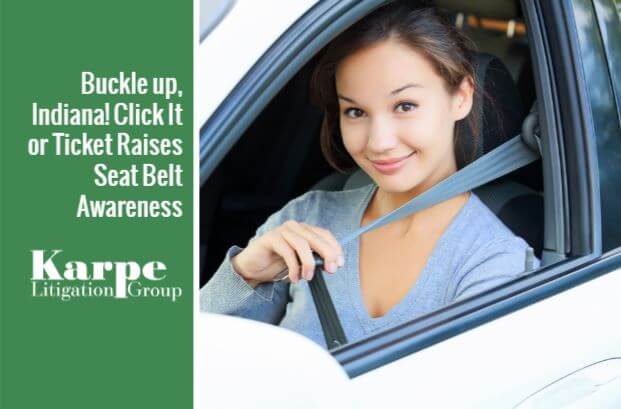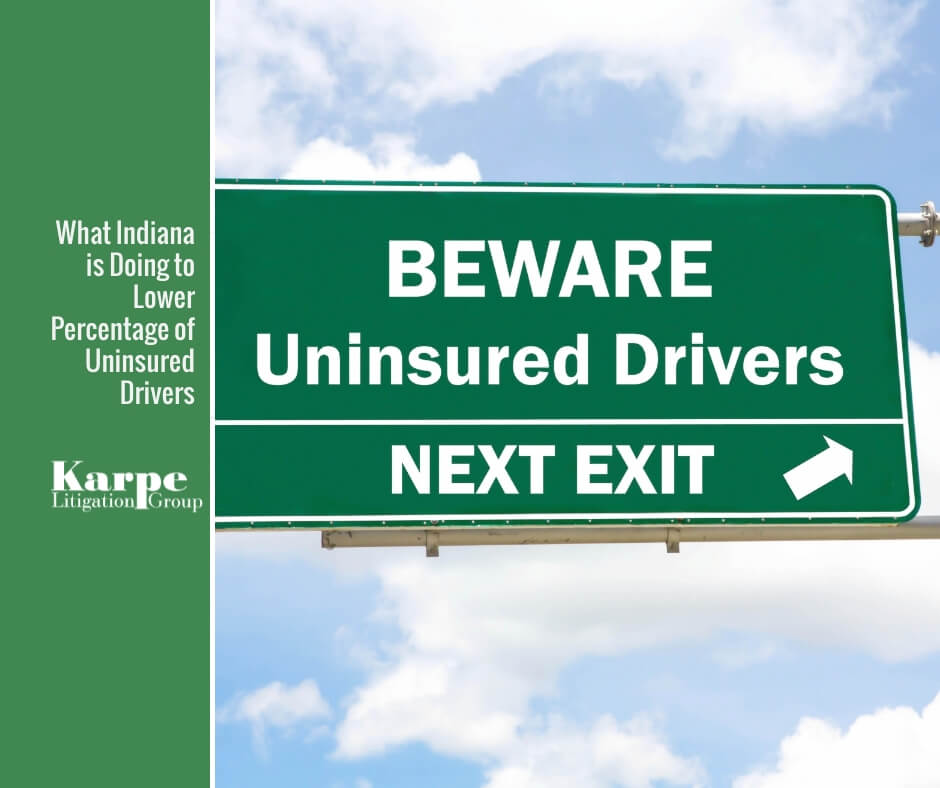Wearing a seat belt not only protects drivers and passengers, this Indiana law saves Hoosier lives.
Police are out in increased numbers to enforce Indiana’s mandatory seat belt laws. Participating in the national Click It or Ticket campaign, Indiana law enforcement is working overtime, giving citations to drivers who fail to wear seat belts while driving or riding in vehicles.
The overtime pay for officers is covered by a grant from the National Highway Traffic Safety Administration. Over 230 law enforcement agencies in Indiana participate in the annual campaign, patrolling day and night to bring awareness of seat belt safety to drivers and passengers, both in front seats and in the back.
Seat Belts Save Hoosiers
Seat belts protect drivers and passengers, even in non-serious crashes. “These are crashes that, when you look at the vehicle, you think someone maybe got a little banged up, and then you find out they were killed because they got ejected,” Indiana State Police Captain Dave Bursten tells local Indianapolis radio station WIBC. “No one plans on being in a crash. But crashes happen. And once the crash happens, you can’t freeze-frame and put your seat belt on to protect yourself. You do that by putting it on as soon as you get in the car before you pull out to drive.”
Seat Belts Decrease the Likelihood of Death
Drivers of cars and SUVs who are unrestrained by seat belts are 10 times more likely to die in a crash than those wearing a seat belt. The number rises to 14 times more likely for drivers of pick-up trucks and 15 times more likely for drivers of vans.
Lt. Jefferey Paine of the Indiana State Police tells local Indianapolis news station WTHR, “It is absolutely heartbreaking to see the aftermath of a crash where a fatality could have been prevented by wearing a seat belt. Click It or Ticket is more than an enforcement campaign, it is an educational effort to increase seat belt use and decrease fatal crashes.”
Younger Male Drivers More At Risk
Male drivers aged 15 to 44, especially those under 25, are most likely to not be wearing a seatbelt at the time of a crash, according to State Police. Injury rates for unrestrained drivers and passengers are also higher:
- in rural counties
- when a driver is speeding or impaired
- on weekend nights between the hours of 11:00 pm and 4:00 am
In fact, Indiana motorists are more likely to suffer property damage, injuries or death from a traffic accident than to experience a burglary, to be the victim of a violent crime or to be murdered.
Click It or Ticket Through the Years
Prior to 1980, seat belt usage in the United States averages about 11%. In 1980, small campaigns to increase seat belt usage begin to pop up. Individual organizations, public education programs, incentives and policy changes work to change perceptions. However, without any actual laws on the books, these efforts only make a slight difference. By 1984, seat belt usage only climbs four percentage points.
New York becomes the first state to enact mandatory seat belt laws in 1984 and by 1990 an additional 37 states have seat belt laws on the books. At the time, most of these states have “secondary seat belt laws,” meaning an officer would first have to have pulled over a vehicle for another violation before citing the lack of seat belt use. Even so, the national rate of seat belt usage climbs from 15% to 50%.
The Click It or Ticket campaign begins as a statewide effort in 1993 when North Carolina Governor Jim Hunt launches it in conjunction with a “primary enforcement safety belt law,” which allows officers to issue seat belt citations without first observing another offense. Other states follow and in 2002 the National Highway Transportation Safety Administration starts the first national campaign.
Enforcing for Safety
The campaign has been deemed a success by its backers. The U.S. Department of Transportation releases a statement in May 2003, “National belt use among young men and women ages 16-24 moved from 65% to 72%, and 73% to 80% respectively, while belt use in the overall population increased from 75% to 79%.”
In 2018, the 230 agencies involved with enforcing the Click It or Ticket campaign in Indiana put in nearly 29,000 hours of overtime to crack down on seat belt violations and write 32,000 citations and warnings.
Make Sure You are Properly Buckled
Indiana State Police provides reminders on how to properly “buckle up”:
- Secure the lap belt across your hips and pelvis, below your stomach.
- Place the shoulder belt across the middle of your chest and rib cage, away from your neck.
- Never put the shoulder belt behind your back or under an arm.
- If your seat belt doesn’t fit you, or you have an older car with lap belts only, ask your dealer or vehicle manufacturer about seat-belt adjusters, extenders or retrofits.
Senior Trooper Nick Klinghammer of the Indiana State Police tells local Indianapolis station RTV6, “Most times you’re involved in a crash, it’s within five to10 miles of your house, so hopefully we prevented something here. If you don’t click it, you’ll get a ticket.”
Personal Attention from Professional Attorneys
If you have been involved with a seat belt violation, talk to the professional attorneys at Karpe Litigation Group today. We are experts in auto accident law, winning the most challenging cases and helping those in need for 20 years and counting. There is no fee until we win for you. Committed to making things easy for you, we are happy to meet by appointment on evenings and weekends, and travel to you when needed. Give us a call today at 1-888-228-7800 or fill out our contact form to schedule your free initial consultation.





